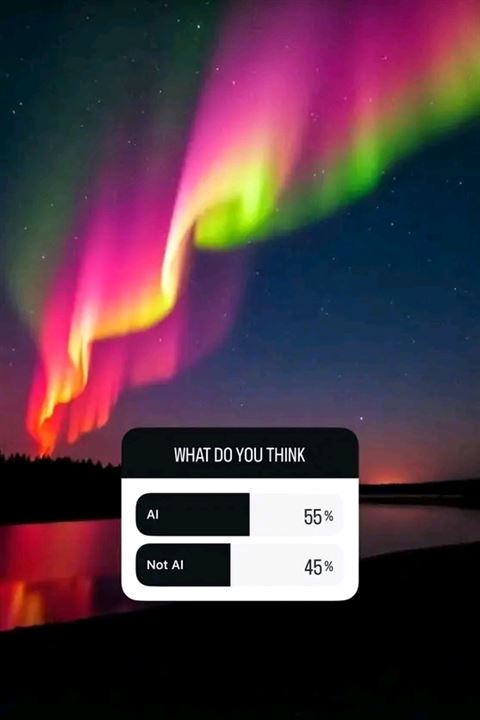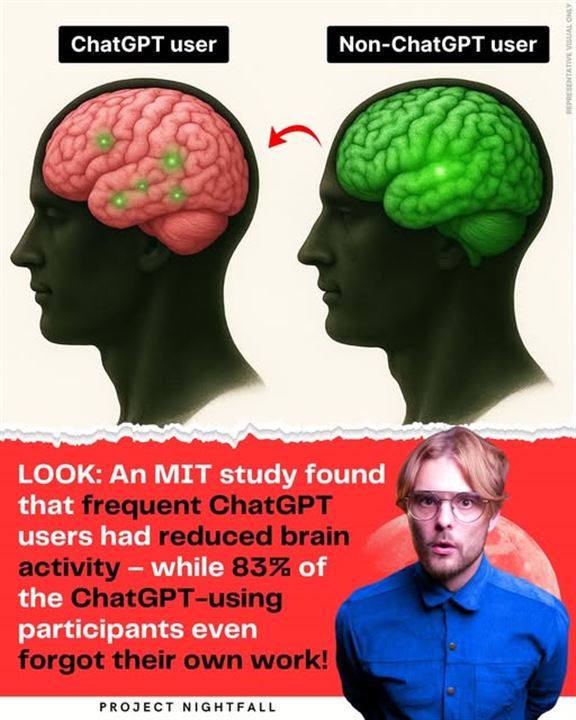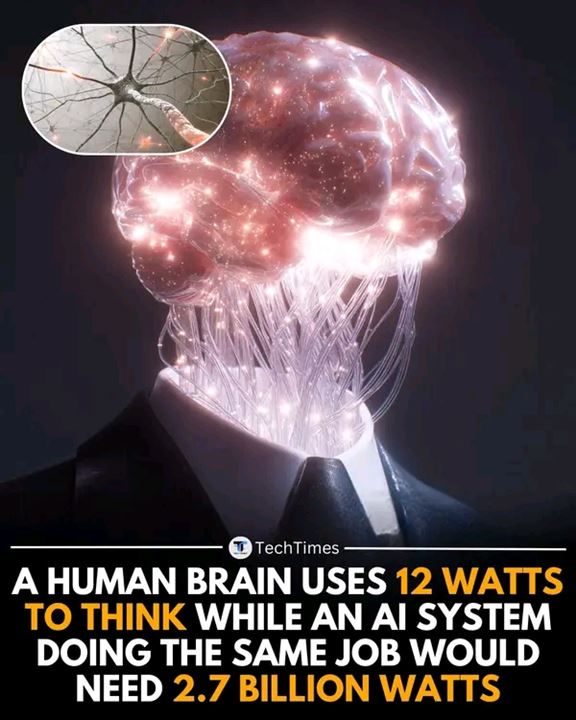
[Edit 22/6/2025] Unfortunately the fact that some people tend to pass AI-generated or work by other authors off as their own, has necessitated that contest sponsors take steps to ensure the integrity of the contest results - a responsibility they were charged with by PS (see footnote to this blog).
The overreliance on AI generative work not only makes you lazy to think for yourself and effectively kills creativity, a recent study by MIT (USA) has found that it in fact also makes one forgetful (perhaps a euphemism for ‘stupid’?): The MIT study is called “Your Brain on ChatGPT: Accumulation of Cognitive Debt when Using an AI Assistant for Essay Writing Task”.
Identifying the possible use of AI (in poetry and elsewhere) is no less important than learning how to discern fake news.
The AI Factor:
An inconsistency across a number of poems by the same poet, strongly supports AI authorship, as it aligns with the variability seen when different prompts are used. A human poet might experiment across forms, but the lack of any stylistic or thematic thread—and the shift to clichéd language or stock poetry phrases, strongly suggests AI with prompts of varying specificity.
The above is an extract from my latest article (another arrow in your quiver):
https://www.poetrysoup.com/article/poetic_voice__poets_reasonable_growth_arc-5228
Identifying AI Fingerprints in Contest Submissions A practical companion for assessing authenticity, coherence, and poetic integrity.
1. Clarity, Structure & Lineation
- Linear meaning: AI-generated poems often explain rather than evoke. There is little space left for interpretation, and metaphors arrive fully decoded.
- Syntax & phrasing: Expect short, declarative sentences—e.g., “Poetry that bleeds on the page.” AI avoids linguistic risk to maintain clarity.
- Abrupt or didactic endings: Closures tend to “wrap up” with overly resolved conclusions or moral tones.
- Forced enjambment: Lacks intuition in line breaks—results feel mechanical or clipped. Rarely mimics fluid or emotionally resonant enjambment.
2. Metre, Form & Formal Constraint
- Clinically correct metre: Often defaults to 8-syllable iambs in free verse. Cannot convincingly execute syllabic verse (see Suzette Prime) or variants like the Suznet.
- Overreliance on known forms: Sonnets (especially Shakespearian) are its stronghold. Variants requiring tonal shifts or structural elasticity reveal AI’s limitations.
- Inconsistent line counts: Tends to produce one line short when a title is miscounted as a line.
- Repetition: Overused and formulaic, especially in villanelles, pantoums, or limericks. Predictable rhythmic patterns suggest automated generation.
3. Rhyme & Sound Devices
- Simplistic rhymes: Common rhymes paired with forced, less-idiomatic matches (e.g., “composer/transposer”).
- Default to rhyme: Even in free verse, rhyme often appears unprompted.
- Alliteration overload: Frequently forced, lacks organic integration with tone or theme.
- Internal rhyme clichés: Used for musicality but disconnected from emotional depth.
4. Imagery, Metaphor & Voice
- Mixed imagery: AI lacks focus—multiple image threads may dilute emotional clarity.
- Clichéd metaphor: Highly recurrent or romanticised tropes; e.g., “reflected in your tearful soul.”
- Overused AI metaphors: Watch for recurring phrases like “fractured light,” “echoes in the void,” or “memory folds into dusk.”
- Echo Hallmark effect: Some lines appear across unrelated poems—an uncanny AI giveaway.
- Synesthetic misfires: Contrived pairings like “taste of mourning in violet rust” signal algorithmic mashups, not lived experience.
- Glitch metaphor: Plausible-sounding metaphors that unravel under scrutiny (e.g., “his silence split like citrus on glass”).

5. Stylistic Consistency & Layout
- Tone drift: Sudden shifts between archaic diction and modern idioms; suggests style mismatch rather than intentional juxtaposition.
- Excessive symmetry: Line structures show unnatural balance or mirroring—predictability over expressive range.
- Title case default: AI often capitalises each word in the title unless explicitly instructed otherwise.
- Unusual bold text: In copy-pasted contest entries, some words appear mysteriously bold—likely stemming from system-based AI formatting artefacts. At times, whole words are inexplicably capitalised in the content of the poem.
- Visual misuse: AI struggles with concrete visual prompts; excels in vague thematic prompts like “Write a 10-line poem about 'lekker.’”
6. Poetic Intent & Emotional Resonance
- Lack of negative space: AI fills the canvas—little silence, fragmentation, or ambiguity. Avoids what it can’t measure.
- Unanchored imagery: Broadly romantic and emotionally evocative, but lacking in personal nuance or cultural specificity.
- No “poetic fingerprints”: Newer poets using AI often echo the sponsor’s example poem. A severe deviation from the poet’s earlier voice is a red flag. Some (old or new poets) even “rework” the sponsor’s example poem(s) by putting it through an AI blender—a new form of plagiarism!
- Flattened emotional complexity: With advanced models like Grok 3 and DeepSeek, AI can now mimic emotive tones, but authentic poems often reveal struggle, contradiction, or hesitation—what AI still renders too smoothly.
7. Technical Quirks & Formatting Clues
- Em dash overuse: Consistently chosen over en dashes, ellipses, or standard punctuation—though some human poets use it stylistically.
- Excessive parentheses: A mechanical attempt to layer meaning instead of weaving nuance through tone and metaphor.
- Syllable inaccuracy: Syllables are miscounted across lines. Crucial in syllabic forms (e.g., Suzette Prime).
- Rare or obscure vocabulary: Words like, marrowed, etc. may signal stylistic inflation—less to impress, more to obfuscate.
- Misalignment with visual prompts: AI cannot interpret images; if the submission seems disconnected from a clear visual or photograph, be wary.
Final Notes
AI-generated poems are increasingly emotive, well-structured, and stylistically convincing—but their tell lies in constraint response, image economy, rhythmic instinct, and intuitive disruption. Forms like the Suzette Swan Arc that reward emotional oscillation and formal looseness remain ideal litmus tests.
If a submission "feels familiar" yet polished—trust that instinct. The true giveaway may not be what is said, but what the poem avoids: struggle, silence, surprise.

MY MESSAGE TO ALL SPONSORS
The above list was refined for clarity by Microsoft Copilot, using my notes collected over the past year and a half. The AI checker Scribbr is a quick stop to check for AI-generated poetry, but might show a negative result (0% AI probability) when the poem has been “humanised” by a computer programme. A zero-AI check doesn’t guarantee untouched authorship—it’s plausible a poet rewrote or repurposed AI output with emotional intention and human edits that slip past detection.
AI Detector - Trusted AI Checker for ChatGPT, Copilot & Gemini (scribbr.com)
However, if you are still unsure, I can recommend Grok 3 (a FREE programme) to supply a detailed analysis using the following prompt (or something along these lines, as long as you “don’t lead the witness”—the aim is for an objective report) together with the poem to be checked:
Identify any AI markers alongside the human finger prints with the view to establish authorship, and include a conclusion of the results.
In an era where algorithms emulate emotion and syntax with startling fluency, sponsors must move beyond tradition-as-refuge. This guide invites discernment, not distrust; evolution, not elitism. When the tools change, so must the terms of stewardship. What we reward now defines what poetry becomes next. What you as reader applauds now in no less significant – rubbing the fake gold paint of the potbelly of a plastic Buddha will not bring you luck; only grief as you lose the ability to discern what constitutes good poetry
After all, on the contest page, under the heading How to Win: It does not state: at all cost.
Study the past winners of a contest sponsored by that member.
Just a friendly reminder: PoetrySoup clearly states on the poetry submission form that no AI-generated poems are allowed. This is not a witch hunt, but my small contribution to aid sponsors who seek to keep poetry in the hands of poets.
Happy quills!
~Su, 20/6/2025
Disclaimer: Any example used to illustrate a point made, is my own and not from anyone's poem I have read here at PoetrySoup or on any other platform where poetry is posted on a regular basis, eg in 2013 I ran a contest about the Afrikaans word 'lekker'.

The above is an AI-generated picture to illustrate the point made in the introduction - June 2025.
[Edit, 21/6/2025] An extract form a letter received from PoetrySoup, dd 29/6/2024:
“Detecting AI-Generated Poems
- Inconsistencies in Style: One way to detect AI-generated poems is to look for inconsistencies in the style and tone of the writing. AI may struggle to maintain a consistent voice throughout a poem.
- Unusual Syntax or Rhyme Patterns: AI-generated poems may exhibit unusual syntax or rhyme patterns that seem forced or unnatural. Keep an eye out for patterns that seem too perfect or mechanical.
- Lack of Emotional Depth: Another indicator of AI-generated poems is a lack of emotional depth or personal connection. Genuine poetry often conveys deep emotions and personal experiences that may be missing in AI-generated works.
By paying attention to these clues, readers can better discern between poems written by humans and those generated by AI. … It's important to approach situations with an open mind and not jump to conclusions about AI-generated content. …”
(My note: The last point, ‘Lack of Emotional Depth', is no longer a red flag as new, updated computer programmes can emulate this with ease. Hence my above guide to help people to identify the POSSIBLE use of AI in the design of a poem. The list is not exhaustive—I’ve noted a few points that beggar belief which I thought best not to include as it might identify the poet(s). Like everything else in life, we have free will, and it is not a handbook of absolutes and a manual for a witch hunt.]
